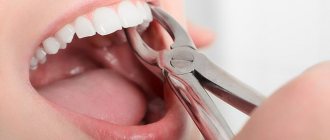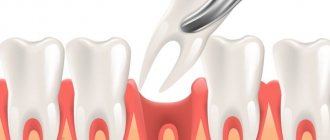Content:
- Peculiarities
- Indications
- Contraindications
- Operation
- Removal methods
- Difficult removal
- Stages
- Diagnostic value
- Does it hurt to remove
- Possible complications
Wisdom teeth or “eight” teeth, located at the edges of the jaw, erupt much later than their counterparts. Moreover, this often happens in adulthood, causing a person many unpleasant moments. The fact is that the structure of the human jaw does not provide enough free space to comfortably accommodate an additional pair of teeth. Therefore, “eights” often put pressure on “sevens”, they grow at an angle, their roots become curved, and it can be difficult to provide them with proper hygienic care, as a result of which caries develops. The peculiarities of the location do not allow for high-quality treatment of the wisdom tooth, and the optimal solution is its removal, since it bears neither a functional nor an aesthetic load.
Features of the structure of wisdom teeth
The structure of a wisdom tooth is no different from other molars and consists of a neck, a root system (4–5 pieces) and a crown. In some cases, root development is disrupted and a single conglomerate is formed, that is, a tooth grows with one root.
Its only difference from its neighbors is that recent studies recognize the wisdom tooth as a rudiment that has lost its functional purpose during the evolutionary development of man. Scientists do not consider it as a full-fledged organ, since some part of humanity does not grow it at all.
However, the wisdom tooth has several parameters that distinguish it from the same “seven”:
- lack of milk precursors, which ultimately complicates eruption and impedes growth. There is no room left for it on the dental arch, which is why various developmental pathologies arise;
- the number of roots is greater than that of other molars - up to 5 pieces. In this regard, problems often arise when removing a wisdom tooth;
- significantly curved roots of the “eights” make cleaning and treatment of root canals very difficult;
- poor blood supply compared to other teeth leads to rapid aging, accompanied by fragility and susceptibility of tissues to caries, despite minimal load;
- many pathological conditions, for example, pathologies of the masticatory muscles, malocclusion, pericoronitis, are associated with the growth of “eights”.
Thus, the appearance of third molars has many more negative consequences than positive ones. Many patients are forced to see a dentist even before they can be seen in person.
Child died after tooth extraction
The presence or absence of a cause-and-effect relationship between the medical procedure performed and the death of the child will be determined by a forensic examination - so far the Vladimir SledCom has only published the circumstances of this tragic incident.
A criminal case into the death of a 5-year-old girl was initiated under Part 1 of Art. 109 of the Criminal Code of the Russian Federation - causing death by negligence. As Zebra TV was told by the Investigative Committee of the Investigative Committee for the Vladimir Region, a family from Uzbekistan arrived in Kovrov in May 2014. The parents are quite young - they are about 30 years old, the father received a patent for work and began to earn bread, the mother of a 5-year-old girl stayed at home. As they say in the Investigative Committee, the child was not legalized in Russia at all - that is, the girl did not go to kindergarten and was not registered at the clinic.
And on January 1, 2015, the girl had a toothache, so bad that painkillers didn’t help. The parents did not contact either the ambulance or the doctor on duty at the relevant children's medical institution. Compatriots recommended a dentist - a woman whose medical experience is already 57 years. That is, the doctor whom the natives of Uzbekistan contacted on January 3 is well over 70, she has been retired for 3 years, and she sees patients at her home. As investigators say, the apartment had everything necessary to provide dental care, including sterile syringes, tampons, sterilization containers, etc.
The experienced doctor was generally horrified by the state of the child’s oral cavity - she later said that it was possible to at least remove all the teeth there. But she removed one, the one that hurt - a molar milk tooth with purulent growths. In this case, anesthesia was performed using lidocaine, the procedure was carried out using professional instruments.
It was around 6 pm, the child tolerated the tooth extraction normally - the girl came home herself and almost immediately went to bed. And then the child began to have convulsions, after which she fell into a coma. The ambulance, as they say in the Investigative Committee, arrived almost instantly - the girl was taken to the intensive care unit of a local hospital, where, with a preliminary diagnosis of sepsis, failure syndrome, cerebral edema, she was provided with qualified care, which did not bring a positive result. In the early morning of January 4, 2015, the girl died.
Currently, investigative actions are being carried out to establish all the circumstances of the incident. Using specialized techniques, histological, biological and bacteriological examinations are carried out to establish the exact cause of death of the victim.
Indications for wisdom tooth removal
Treating third molars is a challenging task, but a competent dentist will try to keep the unit relatively healthy. However, in practice, even relatively healthy “eights” are extremely rare.
Most often, problems begin at the teething stage, which is associated with pain, fever, swelling and other troubles. The doctor prescribes wisdom tooth removal if:
- an unerupted molar is incorrectly positioned in the jaw, injuring neighboring teeth and soft tissues;
- extensive caries damage with significant destruction of the crown;
- pericoronitis (presence of an inflamed hood);
- installation of a bracket system. Sometimes only the removal of a wisdom tooth can ensure the correct movement of other molars;
- presence of a cyst;
- the trigeminal nerve is pinched;
- pulpitis, periodontitis.
Most experts are inclined to believe that the “eight” should be under the supervision of a doctor from the moment of eruption. An x-ray is sufficient to assess the development of the tooth and assess future prospects. This needs to be done immediately, if only because for young people the rehabilitation period is much easier and the likelihood of complications is minimal.
Contraindications to wisdom tooth removal
Despite all of the above, there are situations when the mouth cannot do without the “eight” or the operation cannot be performed for other reasons:
- you need to install a bridge supported by the third molar;
- adjacent molars become loose, and a wisdom tooth is used as a base for applying a splint;
- due to the absence of chewing molars, the chewing function falls on it;
- period of pregnancy and breastfeeding;
- cardiovascular pathologies;
- impaired blood circulation;
- allergy to anesthetic;
- hypertensive crisis.
Simple wisdom tooth removal method
For a simple operation, the surgeon uses forceps and an elevator without resorting to incisions or drilling into the bone. This method allows you to extract a molar if:
- the upper wisdom tooth needs to be removed;
- there are no significant developmental deviations;
- there are no complicating circumstances.
Wisdom tooth removal proceeds as follows:
- 1. The dentist collects anamnesis, inquires about the patient’s allergic reactions to medications, and selects the optimal anesthesia;
- 2. an anesthetic drug is administered, its effect begins after about 5 minutes;
- 3. the surgeon prepares instruments, the sets of which differ depending on the location of the tooth, its condition, and the presence of inflammation;
- 4. Using forceps or using an elevator, the tooth is removed from the socket;
- 5. The doctor treats a fresh wound with antiseptic drugs;
- 6. If necessary, an anti-inflammatory agent is placed in the hole.
After the removal of wisdom teeth, large sockets remain, so the surgeon sutures the tissue to prevent infection and speed up healing. In the presence of purulent processes and inflammation, suturing the hole is not advisable, since the contents must have an unimpeded outflow. The manipulation usually takes no more than 10 minutes. To monitor the patient’s condition, the doctor schedules an examination a few days after the operation to remove the diseased wisdom tooth.
How is wisdom tooth removal performed in our clinic?
- Before the procedure itself, the patient undergoes diagnostics from the surgeon, as well as, if necessary, professional hygiene and sanitation of the oral cavity.
- Antiseptic treatment of the surgical field is carried out.
- Introduction of anesthesia. Usually, 10-15 minutes are enough for it to start working.
- The tooth itself is extracted using a suitable method.
- After which, if incisions were made, or the resulting hole is too large, sutures are applied.
- Tamponade is performed to stop bleeding.
Complex wisdom tooth removal
During such an operation, the surgeon uses many more instruments and performs more complex manipulations, in particular, cutting soft tissues and suturing the incision without fail.
Complex removal is carried out if:
- we are talking about removing the lower wisdom tooth;
- there is an abnormal root system;
- the coronal part is severely destroyed;
- impacted, dystopic molars.
Preparation for the operation follows approximately the same pattern as for simple wisdom tooth removal, but this is where the similarities end. This is noticeable already at the initial stage: more time is allocated for the effects of anesthesia - about 10 minutes.
Clinic doctors
The most difficult manual work in all surgical dentistry is the removal of wisdom teeth. How many people there are - so many variations of structures and cutting of eights can be found in nature. It is very difficult to predict which tooth will appear. How to deal with a “mysterious stranger”?
ESTABLISHED BY NATURE
In relation to the human body, nature rarely acts rashly. Wisdom teeth are just that case of a hereditary error that we inherited from distant ancestors, whom they served to skillfully cope with pieces of raw meat.
The need to chew such a rough and unyielding product disappeared several thousand years ago; softer food reduced the load on the jaws - they decreased in size. But the “working tool”—the wisdom teeth—remained.
The appearance of eights has been surrounded by myths, legends and speculation since ancient times. The name of the teeth was given by the ancient Slavs, who believed that only a person with rich life experience could acquire these “magnificent four.” Nomadic peoples believed that eights buried in a cemetery promised fabulous wealth. But here is the most ridiculous aesthetic assumption of our days: if you remove wisdom teeth, your cheeks will not protrude, and your face shape will become ideal. Among the misconceptions is the myth that “powerful” wisdom teeth can take calcium from other teeth or “move” their row so that the front teeth bunch up.
For most people, the most mysterious and painful teething occurs between the ages of 16 and 26. At this time, the growth of the jaw bones slows down greatly - in most patients, the delayed teeth simply do not fit in the mouth. It seems that they live their own lives and do what they please: they injure the gums and “neighbors”, crawl out in the other direction, and lead to infection.
There are three classic scenarios for the development of events: figure eights either erupt easily and naturally (the person’s bite is fine and there is enough space for everyone), or with pain and inflammation (the so-called pericoronitis develops), or they remain in the jaw and do not erupt at all (impacted teeth require consultation with an orthodontist). The most dangerous, of course, is the second case: pericoronitis or inflammation of the mucous membrane around and above the erupting tooth. In addition to the fact that this is an unpleasant, painful and very dangerous process, it also indicates that the patient has an orthodontic problem that needs to be solved urgently.
WHO IS TO BLAME AND WHAT TO DO
When the “follicle” - the sac in which the tooth develops - leaves the bone tissue and fuses with the gum, a kind of “pocket” or “hood” of the mucous membrane is formed over the crown of the tooth. At some point, it partially breaks through - saliva and food debris begin to get into it. The space under the “hood” is an excellent habitat for bacteria and helps for the development of infection. If there are no obstacles, the tooth will continue to grow and will soon begin to actively participate in chewing. When a tooth does not have enough space, it can erupt higher, to the side, or begin a sadistic turn along the plane.
If the problem is not treated or the pain is managed with “grandmother’s” remedies and lotions, then the inflammatory process will quickly leave the gums and spread further. The infection can lead to the development of phlegmon, abscesses, and ulcers, which will require serious treatment in a hospital, including intensive care. Wisdom teeth can cause fever, trouble swallowing, muscle inflammation, or swelling that prevents you from closing your mouth.
In many clinics, doctors still practice the “old-fashioned method” of dentistry or “hood excision.” The mucous membrane above the tooth is incised, allowing free passage. Alas, this method is effective only in those rare cases when the figure eight erupts normally even without a notch. In the rest, this is just a delay in the painful fact, the “hood” will grow again, and pericoronitis and all the consequences arising from it will return with renewed vigor. Do not wait or hope that the unpleasant and debilitating pain will go away on its own. Contact the dental clinic immediately!
The only correct method of treatment is removal of the causative wisdom tooth. In modern dentistry, the procedure takes from 10 minutes to half an hour, while eliminating hundreds of problems. There is a story that it is very painful to remove a wisdom tooth. This is not at all true, given the anesthesia factor. Under the influence of an anesthetic, the doctor will cut the gum and remove the tooth in whole or in parts. You won't feel anything at all.
After the operation, the patient needs to monitor his own condition for several days and follow a diet. In just one or two weeks the whole process will calm down completely. And you will heal as if there were never any problems with your wise teeth.
Stages of complex wisdom tooth removal
The methodology may differ for each specific case, but in general terms several approximate stages can be outlined:
- 1. local anesthesia;
- 2. incision of soft tissues, peeling them off the bone;
- 3. sawing, drilling out the proper bone tissue;
- 4. extracting the “eight”;
- 5. treatment of a fresh hole left after the removal of a diseased wisdom tooth;
- 6. suturing with non-absorbable suture material;
- 7. The doctor will remove the stitches only after the edges of the wound have completely fused.
The duration of the procedure depends on the situation and can last from 30 minutes to 2 hours. After the operation, the doctor advises the patient regarding wound care, prescribes medications and informs the date of the next appointment.
The value of x-ray diagnostics when removing wisdom teeth
No qualified doctor will remove wisdom teeth “blindly”. You cannot rely on external indicators. A clear assessment of the condition of the root system and the development of the tooth is necessary in order to eliminate complications that could arise after the operation. An x-ray must be taken to assess the feasibility of removing a particular wisdom tooth.
X-ray examination provides an informative picture that allows you to see:
- the presence of curved roots;
- number of root shoots;
- structural features.
Based on the results of X-ray diagnostics, the doctor will be able to draw up a surgical plan and eliminate errors in the form of bone fragments remaining in the gum.
Is it painful to remove a wisdom tooth?
Many patients delay wisdom tooth removal due to fear of pain. Such fears in modern dentistry are absolutely groundless, since anesthetics are necessarily used for the procedure. Discomfort occurs when the effect of the drugs wears off and the analgesic effect decreases. But this is a physiological process that fades away on its own after some time. In addition, there is absolutely no need to endure pain; the doctor will prescribe medications to alleviate the postoperative condition.
When removing a wisdom tooth, some patients experience painful symptoms for a number of reasons:
- drug addiction;
- extensive purulent process;
- abuse of painkillers.
Also, the degree of pain depends on the method of removal, the condition of the wisdom tooth, and its location. For example, surgery on the upper jaw is easier. But removing a wisdom tooth from the lower jaw is more problematic due to the structural features of the jaw and large curved roots.
Anesthesia.
To remove even the most difficult wisdom teeth, local anesthesia is sufficient.
Firstly, it is as safe as you can imagine and is suitable for absolutely everyone. Properly administered local anesthesia is at least several hours of persistent pain relief, sufficient to not only remove wisdom teeth, but also perform rhinoplasty and mammoplasty as a gift.
Secondly, local anesthesia has one significant advantage. In our opinion, the most important thing is maintaining verbal and non-verbal contact with the patient. Local anesthesia and preservation of all cognitive functions, at a minimum, eliminate treating the patient like a piece of meat - we feel you, worry with you and strive to cause as little discomfort as possible. A number of researchers have studied the morbidity and incidence of complications, comparing operations under local and general anesthesia, and the results of the studies were far from in favor of the latter. And there is an explanation for this. The lack of reactions on the part of the patient under sedation “frees the hands” of the surgeon; direct and feedback connections are lost between him and the patient - because of this, the traumatic nature of the operation increases sharply.
For local anesthesia when removing wisdom teeth, we use anesthetics familiar to all dentists. Mainly based on Articaine - as the most effective and safe.
Possible complications
Wisdom tooth removal is one of the most difficult operations in dentistry. Therefore, after it is carried out, various complications cannot be excluded. Thus, during the operation, neighboring “sevens” are sometimes damaged. Such severe consequences are the result of incorrectly chosen treatment tactics, as well as the low qualifications of the dentist, who was unable to understand the peculiarities of the patient’s anatomical structure.
Mature patients in some cases experience damage to the nervous system and, as a result, impaired sensitivity and numbness. Young patients encounter such disorders much less frequently.
A few hours after the removal of a wisdom tooth, bleeding may develop, which is most often provoked by intense rinsing, irritating the wound with the tongue, or eating hot food. This disorder is especially dangerous for patients suffering from hypertension and bleeding disorders.
Dry socket is the most common postoperative complication. Normally, after a wisdom tooth is removed, a blood clot forms in the socket, which promotes rapid healing of the wound. Sometimes a clot does not form, most often in smokers. After a few days, acute pain may appear, for which you should definitely consult a doctor.
Alveolitis after tooth extraction: why it occurs, how to identify and treat
Normally, a person forgets about an extracted tooth within a few days. During this time, the pain finally subsides, and the damaged area is overgrown with new epithelium. However, there are cases when tooth extraction is accompanied by serious side effects. One of them - alveolitis - is an inflammatory process that affects the tooth socket and the gum around it. Acute alveolitis requires immediate intervention. Inflammation that begins from the walls of the socket can spread to soft tissue and penetrate deep into the bone. There are cases when it caused such dangerous and painful consequences as periostitis (suppuration and necrosis of the periosteum), osteomyelitis (destruction of the jaw bone), lymphadenitis (damage to the lymph nodes) and even sepsis.
Why does it occur
Alveolitis of the extracted tooth socket is a direct consequence of its infection. There may be several reasons for wound infection: • the complex nature of the removal, requiring an incision in the gum and extraction of the tooth from it by sawing (with complete destruction of the tooth; with curved roots; with increased fragility of the dental tissue; with an unerupted or barely visible wisdom tooth);
• violation by the patient of the requirements of the rehabilitation period (failure to comply with oral hygiene; intensive or frequent rinsing of teeth, which contributes to the premature separation of a blood clot - a natural antibacterial barrier; irritation of the wound with hot, rough or spicy food; smoking).
• poorly performed medical procedure (poor cleaning of the socket with penetration of tartar into it; fragments of crushed bone or fragments of tooth roots left in it; unresolved purulent processes);
Factors that provoke the development of alveolitis may be the following:
• reduced immunity; • hypothermia of the body; • contacts with carriers of infectious diseases; • the presence of acute pathologies of a bacterial or viral nature in the oral cavity or nasopharynx (for example, teeth affected by caries, inflamed gums, tonsils); • gastrointestinal tract infections; • chronic diseases in the acute stage.
How it manifests itself
Pain symptom is the main precursor to the development of alveolitis. If, with a successful outcome of tooth extraction, the unpleasant sensations gradually disappear after a few days, then with alveolitis, everything happens exactly the opposite. The pain does not leave the patient, but intensifies, reaching its peak on days 2-5 after surgery. Having arisen in an injured socket, it can cover the entire maxillofacial area, spreading to the ear, temporal region or neck.
In addition to pain, the patient may be bothered by the following manifestations of the disease:
• general malaise, loss of strength, temperature rise to 38°C; • inflammation of the submandibular lymph nodes; • smell of rotting breath; • yellowish-gray plaque inside the socket freed from the thrombus; • blood-red color of the gums, its soreness and swelling; • a bitter taste that often appears in the mouth; • cheek swollen from swelling; • activation of secondary foci of oral infection.
Depending on the intensity of the pathological process, its nature is determined by specialists as pronounced, moderate or mild. However, not a single form of this disease can be ignored by the patient.
How to treat
Taking anesthetics and washing the inflamed hole with disinfectant solutions at home is ineffective. They can only reduce, but not stop, the patient’s suffering. The main danger of self-medication is that it can smooth out the symptoms of inflammation. Therefore, in this situation, you cannot do without visiting a dentist. Only a set of procedures will stop the pathological process. The development of a treatment plan is preceded by a thorough diagnosis: visual examination and x-ray or radiovisiography of the dental fossa.
The scheme of medical care for identified alveolitis is as follows:
1. Anesthesia of the inflamed area - anesthesia at the site of inflammation. 2. Curettage of the socket - removal of foreign bodies from it using a special surgical device: tooth fragments or fragments of inert tissue, opening and cleaning out granulations. 3. Repeated rinsing of the hole with an antiseptic and anesthetic drug, followed by placing a special medicine into it, which simultaneously heals, protects the wound and relieves pain. At home, as prescribed by the doctor, the patient takes analgesics, vitamins, and adheres to a gentle diet.
For alveolitis of severe severity, antibiotics with a local or general effect are prescribed. Sometimes dressings with balms and gels are used to soothe the gums. If signs of tissue destruction are detected, proteases are indicated - drugs that improve the microflora in areas of cell death.
The recovery process will be effective if you follow the doctor’s orders every day for 5-7 days.
A set of emergency treatment measures and following all the dentist’s recommendations allows you to quickly achieve the expected effect. After 5-7 days, improvement occurs: the pain goes away, the hole begins to heal. After a few days, the swelling of the gums completely disappears. But even after this, it is necessary to adhere to hygiene standards and other medical prescriptions. It wouldn’t hurt to make a few follow-up visits to a specialist.
Prevention methods
A simple set of primitive measures will help you avoid alveolitis and its serious complications. So, after tooth extraction you should:
• hold the hemostatic tampon in the hole, biting it, for at least 15 minutes; • be careful when caring for the oral cavity and during meals so as not to deprive the socket of a blood clot formed in it; • avoid external factors that contribute to excessive cooling or warming, do not eat or drink anything too hot or too cold; • do not come into contact with infectious patients; • if you have cancer, HIV, or diabetes, notify your dentist about your diagnosis in order to take the necessary course of antibiotics in such cases (it will also not hurt older patients).
By following these recommendations, you will safely avoid infection of the injured area. This will help you preserve the entire row of remaining teeth for a long time.










